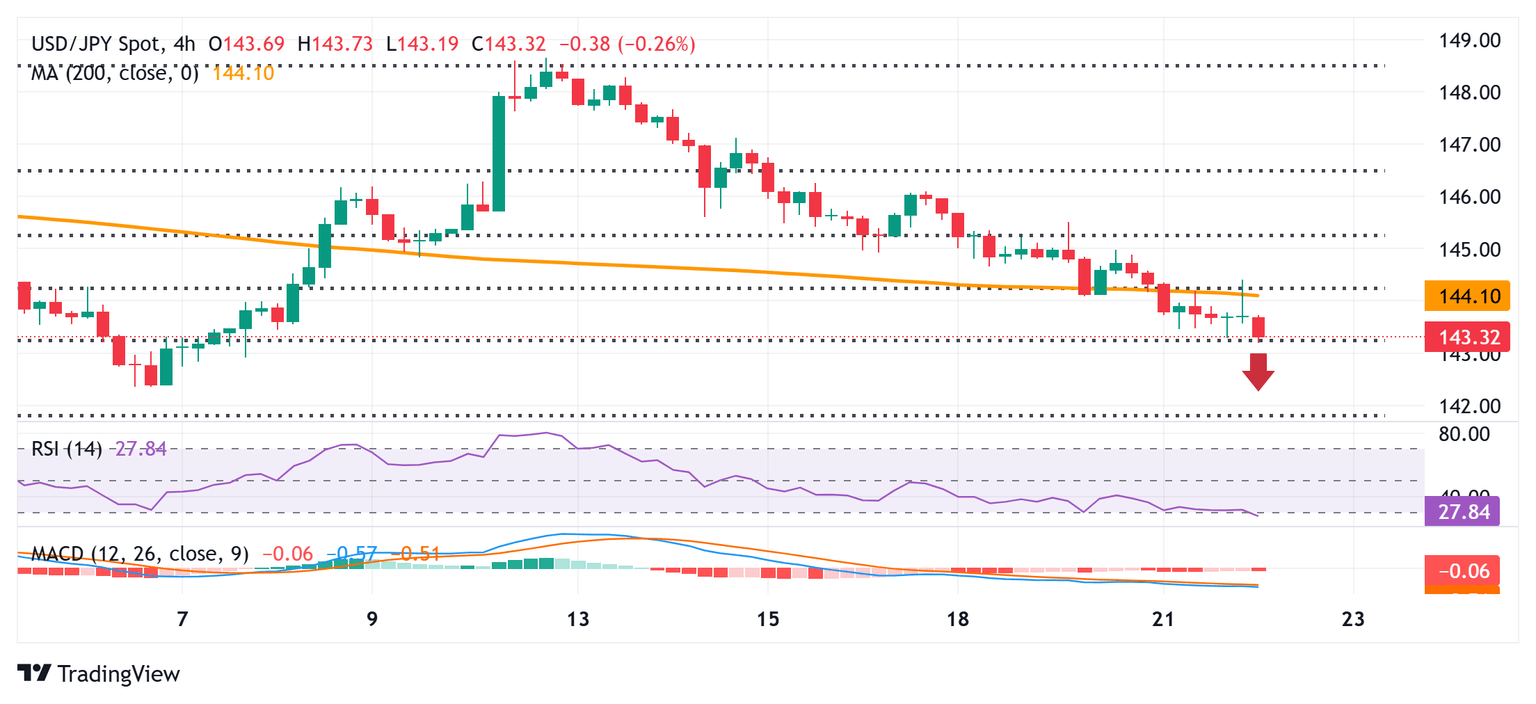Japanese Yen seems poised to appreciate further; USD/JPY hangs near two-week trough
- The Japanese Yen attracted some dip-buyers following upbeat domestic data.
- BoJ rate hike bets and reviving safe-haven demand also lend support to the JPY.
- The prevalent USD selling bias further exerts downward pressure on USD/JPY.

The Japanese Yen (JPY) hits a fresh two-week top against a broadly weaker US Dollar (USD) heading into the European session on Thursday and seems poised to appreciate further. Japan's upbeat Machinery Orders data released earlier today countered recession fears and boosted hopes for an economic recovery. This backs the case for more interest rate hikes by the Bank of Japan (BoJ), which, along with sustained safe-haven buying, continues to act as a tailwind for the JPY.
Furthermore, hopes that Japan will strike a trade deal with the US turned out to be another factor underpinning the JPY. The USD, on the other hand, remains depressed amid concerns about the US government's fiscal health, fueled by US President Donald Trump's proposed sweeping tax bill. Apart from this, bets that the Federal Reserve (Fed) will cut interest rates further this year weigh on the Greenback and validate the near-term positive outlook for the lower-yielding JPY.
Japanese Yen bulls retain control amid a combination of supporting factors
- Data released earlier this Thursday showed that Japan’s Core Machinery Orders – a key leading indicator of capital spending over the next six to nine months – rose 13.0% in March, defying forecasts for a 1.6% decline. This marks the highest level in nearly two decades and assists the Japanese Yen to attract dip-buyers.
- The Bank of Japan recently showed a willingness to hike interest rates further this year amid signs of broadening inflation in Japan. Moreover, investors expect that rising wages could lead to a significant increase in consumption, which, in turn, should allow the central bank to continue on its path of policy normalization.
- Atsushi Mimura, Japan’s Vice Finance Minister for International Affairs and top foreign exchange official, said early Thursday the US did not discuss FX levels at the finance ministers' meeting. Mimura does not believe that there is any gap in understanding with the US and reaffirmed that forex should be determined by the market.
- Investors remain hopeful about progress in trade negotiations between the US and Japan and the possibility of an eventual deal. Japan's Trade Minister Ryosei Akazawa is expected to attend the upcoming third round of ministerial-level talks with US Trade Representative Jamieson Greer. Moreover, US Treasury Secretary Scott Bessent is also likely to take part in the trade negotiations.
- US President Donald Trump's dubbed "One Big, Beautiful Bill" is expected to come to the House floor for a vote sometime on Thursday, and if passed, will add $3 trillion to $5 trillion to the federal deficit over the next ten years. This adds to worries about a deteriorating US fiscal outlook and weighs on investors' sentiment.
- China accused the US of abusing export control measures and violating Geneva trade agreements after the US issued guidance warning companies not to use Huawei's Ascend AI chips. China’s Commerce Ministry said on Wednesday that US measures on advanced chips are ‘typical of unilateral bullying and protectionism.’
- Federal Reserve officials expressed concerns over economic and business sentiment in the wake of the uncertainty tied to the Trump administration's trade policies. Adding to this, a weak 20-year Treasury bond sale reinforced the view that investors are shying away from US assets and kept the US Dollar depressed.
- Trump reportedly told European leaders that Russian President Vladimir Putin isn’t ready to end the war with Ukraine, as he thinks he is winning. Meanwhile, Israel’s military continued to pound the Gaza Strip and block desperately needed food aid. This keeps geopolitical risks in play and further benefits the safe-haven JPY.
- Thursday's release of flash PMIs could provide a fresh insight into the global economic health. Moreover, trade developments should influence the broader risk sentiment. Adding to this, the US macro data – the usual Weekly Initial Jobless Claims and Existing Home Sales – might provide some impetus to the USD/JPY pair.
USD/JPY could consolidate amid slightly oversold RSI on H4; bearish potential intact

From a technical perspective, the USD/JPY pair's intraday move up on Thursday falters near the 144.40 region. The said area nears a confluence support breakpoint – comprising the 50% retracement level of the April-May rally and the 200-period Simple Moving Average (SMA) on the 4-hour chart – and should act as a key pivotal point. A sustained strength beyond could trigger a short-covering move, though it is likely to attract fresh sellers near the 145.00 psychological mark. This should cap spot prices near the 145.35-145.40 region, or the 38.2% Fibo. retracement level, which, if cleared decisively, might shift the near-term bias in favor of bullish traders.
Meanwhile, oscillators on the daily chart have just started gaining negative traction and suggest that the path of least resistance for the USD/JPY pair remains to the downside. However, the Relative Strength Index (RSI) on the 4-hour chart has moved on the verge of breaking into oversold territory, making it prudent to wait for some near-term consolidation before positioning for the next leg of a downfall. That said, acceptance below the 143.20 area, or the 61.8% Fibo. retracement level, might prompt some technical selling and drag spot prices below the 143.00 round figure, to the next relevant support near the 142.40-142.35 area en route to the 142.00 mark.
Tariffs FAQs
Tariffs are customs duties levied on certain merchandise imports or a category of products. Tariffs are designed to help local producers and manufacturers be more competitive in the market by providing a price advantage over similar goods that can be imported. Tariffs are widely used as tools of protectionism, along with trade barriers and import quotas.
Although tariffs and taxes both generate government revenue to fund public goods and services, they have several distinctions. Tariffs are prepaid at the port of entry, while taxes are paid at the time of purchase. Taxes are imposed on individual taxpayers and businesses, while tariffs are paid by importers.
There are two schools of thought among economists regarding the usage of tariffs. While some argue that tariffs are necessary to protect domestic industries and address trade imbalances, others see them as a harmful tool that could potentially drive prices higher over the long term and lead to a damaging trade war by encouraging tit-for-tat tariffs.
During the run-up to the presidential election in November 2024, Donald Trump made it clear that he intends to use tariffs to support the US economy and American producers. In 2024, Mexico, China and Canada accounted for 42% of total US imports. In this period, Mexico stood out as the top exporter with $466.6 billion, according to the US Census Bureau. Hence, Trump wants to focus on these three nations when imposing tariffs. He also plans to use the revenue generated through tariffs to lower personal income taxes.
Author

Haresh Menghani
FXStreet
Haresh Menghani is a detail-oriented professional with 10+ years of extensive experience in analysing the global financial markets.

















